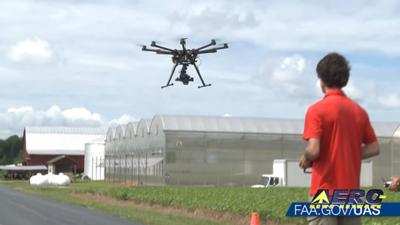Mon, Apr 10, 2017
Association Reminds Farm Drone Operators To Be Extra Cautious About Low-Flying Ag Aircraft This Growing Season
Spring, summer and early fall are for many the happiest time of the year. It's the growing season and farmers and those that assist them are working hard nationwide.

But while we're all enjoying affordable and abundant food, fiber and biofuel, don't forget that our nation's agricultural aviators are flying to help farmers produce it. If you're going to fly a UAV this summer, please be responsible and do everything you can to avoid agricultural aircraft.
Agricultural aviators fly as low as 10 feet off the ground, meaning they share airspace with UAVs that are limited to flying no more than 400 feet above ground level. That's why the National Agricultural Aviation Association (NAAA) is asking UAV operators to do everything they can to avoid ag aircraft doing important, low-level work.
"While flying at speeds that can reach 140+ mph, agricultural aviators are unlikely to see UAVs," NAAA Executive Director Andrew Moore said. "That's why it's so important for UAV operators to protect agricultural aviators in any way they can."
In a test conducted by the Colorado Agricultural Aviation Association, manned and unmanned aircraft organizations, and the state of Colorado, no pilot operating a manned aircraft could continually, visually track a 28-inch-wide drone when flying at regular speeds. While they may be spotted for a second, UAVs are not continually visible to pilots, meaning it's up to the drone operator to avoid a collision.
In addition to lobbying Congress and the Federal Aviation Administration for UAV regulations that protect agricultural aviators and other low-flying manned aircraft, NAAA has enlisted its members and state association partners to help educate farmers, crop consultants, ag retailers and the public about safe and responsible UAV operations in rural areas.
NAAA recommends that UAV operators:
- Become certified and well-trained in operating a UAV.
- Contact local agricultural aviation operators before flying by consulting tiny.cc/findaerialapplicator.
- Equip your UAV with a tracking device, such as ADS-B Out, to send a signal to ag aircraft with similar tracking-reading technology.
- Equip UAVs with strobe lights.
- Give the right-of-way to a manned aircraft. It's the law.
- Land your UAV immediately when a low-flying aircraft is nearby.
- Carry UAV liability insurance.
- Review NAAA's UAV safety video and other UAV safety information at agaviation.org/uavsafety.
When certain birds hit an ag aircraft, they can break through an aircraft's windshield and down an aircraft. They can be lethal. A UAV made of more than feathers, hollow bones and sinew has the potential to be even more deadly.
So, enjoy everything agriculture provides us this growing season, but please remember to operate UAV's safely so ag aviators can keep working and enjoy their growing season too.
(Source: NAAA news release)
More News
“This vote sends an undeniable message to Air Transat management: We are unified, resolute, and have earned a contract that reflects today’s industry standards, not the>[...]
Aero Linx: Beech Aero Club The Beech Aero Club (BAC) is the international type club for owners and pilots of the Beech Musketeer aircraft and its derivatives, the Sport, Super, Sun>[...]
While Landing In The River, The Extended Landing Gear Contacted The Water And The Airplane Nosed Over, Resulting In Substantial Damage Analysis: The pilot of the amphibious airplan>[...]
From 2022 (YouTube Edition): Carrying the Legacy of The B-29 For Generations to Come We had a chance to chat with the Executive Director of B-29 Doc, Josh Wells, during their stop >[...]
Also: Cosmonaut Kicked Out, Airbus Scales Back, AF Silver Star, Russian A-60 Clobbered A Samaritan’s Purse humanitarian flight was hijacked on Tuesday, December 2, while atte>[...]
 Aero-News: Quote of the Day (12.07.25)
Aero-News: Quote of the Day (12.07.25) ANN's Daily Aero-Linx (12.07.25)
ANN's Daily Aero-Linx (12.07.25) NTSB Final Report: Lafferty Jack Sea Rey
NTSB Final Report: Lafferty Jack Sea Rey Classic Aero-TV: The B29 SuperFortress Doc - History in Flight
Classic Aero-TV: The B29 SuperFortress Doc - History in Flight Airborne 12.08.25: Samaritans Purse Hijack, FAA Med Relief, China Rocket Fail
Airborne 12.08.25: Samaritans Purse Hijack, FAA Med Relief, China Rocket Fail



